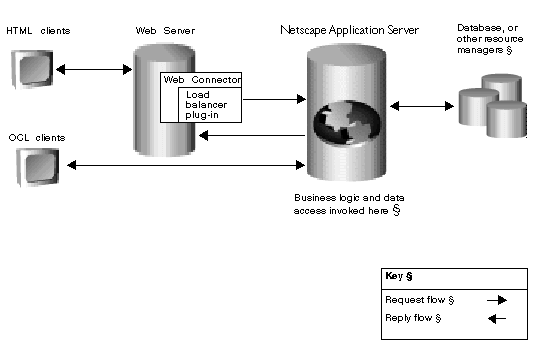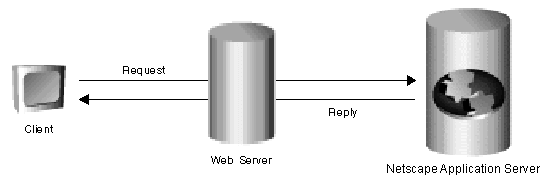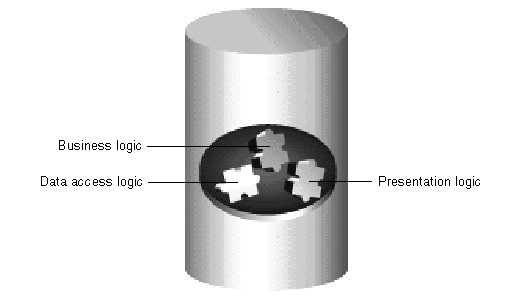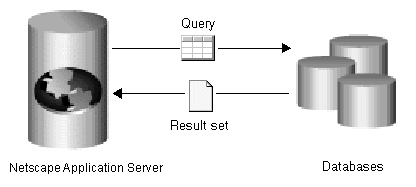|
 What is Middleware?
What is Middleware? |
|
The Netscape Application Server is a middleware server, designed to fit between Web-based clients and databases. The Netscape Application Server does not support an entire business solution on its own.
Rather, the Netscape Application Server works with other technologies to provide high-performance Web access to business-critical solutions. Specifically, the Netscape Application Server facilitates Web access to the components that make up the enterprise, such as
The following illustration depicts a typical enterprise that uses the Netscape Application Server to support business-critical Web solutions:

The next several sections explain each component of the enterprise, following the same order that a request takes as it moves
|
 HTML and OCL Application Clients
HTML and OCL Application Clients |
The client of an enterprise application requests a service of the application. The requested service could be simply to view a list of products' prices, or to update or insert a record in a database.
The client can be either a Web-browser-based HTML client, or an OCL client written in Java or C++ that connects to the server through the Open Client Library (OCL).
In this discussion, the client is the part of the application with which the user interacts, while the user is the person who interacts with the application.
HTML Clients
An HTML client is usually a set of HTML pages that contains forms with data-entry fields and submit buttons. When a user clicks a submit button, the fields in the form specify the request, such as the data to retrieve from a database.
HTML clients are often used in electronic-commerce applications that allow customers to purchase products and services over the Web.
Advantages of HTML Clients
HTML clients are easy to administer because you administer the application only on the Netscape Application Server.
HTML clients are easily distributed and are ideal for Internet applications with many users. For example, an electronic-commerce application that allows anyone in a large market to purchase a product would benefit from using an HTML client.
Disadvantages of HTML Clients
HTML clients do have some drawbacks.
The Web Server and HTML Clients
The Web server is an integral part of HTML client-based applications. The Web server provides both the HTML pages for the application and the answering service that properly routes requests for the HTML clients.
When a request is made for an application,
The Web server forwards the request to the Netscape Application Server.
The Web server waits for the Netscape Application Server to return an answer.
The Web server forwards the reply back to the client.

OCL Clients
OCL clients are Java or C++ applications that use the Netscape Open Client Library to connect to the Netscape Application Server.
Advantages of OCL Clients
When the user base is small, OCL clients can provide better features and performance than HTML clients.
The benefits of OCL clients, such as client-side processing and more controls, can be passed directly to the user as both improved performance and improved application features.
Disadvantages of OCL Clients
Because client files are not easily distributed to a large number of users, and because of administration overhead, OCL clients are most practical in either a limited Internet application or in an intranet application.
|
 AppLogics and the Server
AppLogics and the Server |
|
The Netscape Application Server stores the AppLogic objects that make up the application. AppLogic objects are the core of the application, holding the compiled code instructions written by the developer.
The AppLogic objects contain the business logic, data access logic, and GUI presentation and data formatting logic for the application, as shown in the following illustration:

The application developer designs and develops the AppLogic objects that create the application. Many server services facilitate the development of those AppLogic objects and support the application when it is complete.
Perhaps the most important service that the Netscape Application Server provides is the facilitation and management of database connections. Application developers do not have to write the database connection or query code but, instead, use a high level API that calls into the data access service. The data access service provides the connection to the database and manages the connection threads to that and all databases.
When a request comes into the Netscape Application Server, the server invokes the AppLogic object or objects necessary to answer that request. The correct object is determined by the name or Global Unique Identifier (GUID) of that object, which is supplied as part of the request. If the request requires data access, or any other service, that service is invoked by the server and utilized by the object.
Administration of the Netscape Application Server is actually divided into server administration and application administration.
Server Administration
Administration of the Netscape Application Server comprises administering the services that compose the server as well as configuration of the components the server utilizes, such as the Web server.
Most administration tasks are adjustments to service parameters, such as database connection threads or load balancing parameters, that impact the performance of the applications running on the server.
Application Administration
You also have application administration responsibilities that entail the management of the AppLogic objects that compose an application. Such tasks include grouping and enabling AppLogic objects or partitioning those objects for better application performance.
|
 About the Database
About the Database |
|
The information needed by most business-critical applications is typically stored and managed in a database. When an application submits a query to a database, the database retrieves that record or records and returns them to the Netscape Application Server in a result set, as shown in the following illustration:

The AppLogic objects on the Netscape Application Server maintain transactional integrity with the database to which the server connects. Transactional integrity is maintained by using API calls provided by the data access service.
Transactional integrity ensures that data and records are updated in the database properly and that data remains consistent. In addition, the Netscape Application Server manages the connection threads used when connecting to a database.
The Netscape Application Server can connect to many databases, such as Oracle, DB2, Informix, Sybase, and Microsoft SQL server, natively or through ODBC connection software packages. You can configure database drivers to optimize the performance of the applications accessing the databases.
For more information about database drivers, see "About Working with Databases."
|
|
|

|